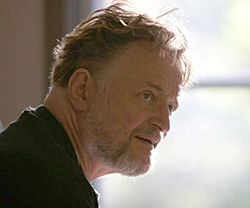John Horton Conway facts for kids
Quick facts for kids
John Horton Conway
|
|
|---|---|

Conway in June 2005
|
|
| Born | 26 December 1937 Liverpool, England
|
| Died | 11 April 2020 (aged 82) New Brunswick, New Jersey, U.S.
|
| Education | Gonville and Caius College, Cambridge (BA, MA, PhD) |
| Known for |
|
| Awards |
|
| Scientific career | |
| Fields | Mathematics |
| Institutions | University of Cambridge Princeton University |
| Thesis | Homogeneous ordered sets (1964) |
| Doctoral advisor | Harold Davenport |
| Doctoral students |
|
John Horton Conway (December 26, 1937 – April 11, 2020) was a famous English mathematician. He worked on many different areas of math. These included knot theory, number theory, and game theory. He also loved recreational mathematics, which is math done for fun. His most famous invention is the cellular automaton called the Game of Life.
Conway was born and grew up in Liverpool, England. He started his career at the University of Cambridge. Later, he moved to the United States. There, he became a professor at Princeton University. He stayed there for the rest of his career. John Conway passed away on April 11, 2020, at age 82.
Contents
Early Life and Education
John Conway was born in Liverpool on December 26, 1937. His parents were Cyril Horton Conway and Agnes Boyce. He became interested in math when he was very young. By age 11, he already knew he wanted to be a mathematician.
After high school, he studied math at Gonville and Caius College, Cambridge. He was a shy teenager. But going to Cambridge helped him become more outgoing. This change later earned him the nickname "the world's most charismatic mathematician."
Conway earned his first degree in 1959. He then started research in number theory with his teacher, Harold Davenport. He solved a difficult problem about writing numbers as sums of fifth powers. During his studies, he also became very interested in games. He spent many hours playing backgammon.
In 1964, Conway earned his PhD. He became a Fellow and Lecturer in Mathematics at Sidney Sussex College, Cambridge. In 1986, he left Cambridge. He then became a math professor at Princeton University. While at Princeton, he even won a pie-eating contest!
Conway and Martin Gardner
John Conway's work was closely connected to Martin Gardner. Gardner was a popular writer about math. In October 1970, Gardner wrote about Conway's Game of Life in his "Mathematical Games" column. This column became very popular and made Conway famous right away.
Gardner and Conway first wrote to each other in the late 1950s. Over the years, Gardner often wrote about Conway's fun math ideas. For example, he wrote about Conway's game of Sprouts and Hackenbush. He also wrote about Conway's "angel and devil problem." In 1976, Gardner explained Conway's surreal numbers in his column.
Conway was a key member of Gardner's "Mathematical Grapevine." This was a group of mathematicians who shared ideas. Conway often visited Gardner and sent him long letters about his research. In 1976, Gardner kept Conway for a week. He wanted to learn everything about Penrose tilings, which were new at the time. Conway had discovered many important things about these tilings. Gardner used Conway's ideas to introduce Penrose tiles to the world in his January 1977 column. The cover of Scientific American magazine that month showed Penrose tiles, based on Conway's own drawing.
Major Areas of Research
The Game of Life

Conway created the Game of Life. It is one of the first examples of a cellular automaton. A cellular automaton is like a grid of cells that change based on simple rules. Conway first worked on it using just paper and pen. This was long before personal computers existed.
Since Martin Gardner made the game famous in 1970, many computer programs and websites have been made about it. It is a favorite topic in recreational mathematics. There is even a special wiki just for the Game of Life. It helps people learn about all parts of the game. The game is also used in computer labs. It helps students learn about programming and showing data.
Conway later felt that the Game of Life became too famous. He thought it took attention away from his other, more important work. But the game helped start a whole new area of math: the study of cellular automata. The Game of Life is also known to be Turing complete. This means it can do anything a computer can do.
Game Theory
Conway also helped create combinatorial game theory (CGT). This is a way to study games where players take turns. He worked with Elwyn Berlekamp and Richard Guy. They wrote a book together called Winning Ways for your Mathematical Plays. Conway also wrote On Numbers and Games (ONAG). This book explains the math behind CGT.
He also helped invent the game sprouts and philosopher's football. He studied many other games and puzzles in detail. These included the Soma cube and peg solitaire. He also created the angel problem, which was solved in 2006.
Conway invented a new system of numbers called surreal numbers. These numbers are connected to certain games. A famous author, Donald Knuth, even wrote a story about them. Conway also created a way to name very large numbers, called Conway chained arrow notation.
Geometry and Shapes
In the 1960s, Conway and Michael Guy found that there are 64 types of special 3D shapes called convex uniform polychora. They discovered a new shape called the grand antiprism during this work. Conway also suggested a way to describe polyhedra (3D shapes with flat faces) called Conway polyhedron notation.
He also created the Conway criterion. This is a quick way to find shapes that can tile a flat surface without gaps. He also studied how shapes can be packed together in higher dimensions. He was the first to find the symmetry group of the Leech lattice.
Knots and Topology
In knot theory, Conway created a new way to describe knots. It is now called the Conway polynomial. This idea became very important in the 1980s. Conway also developed tangle theory. He invented a way to list knots, known as Conway notation. He fixed mistakes in old knot tables and added new knots. The Conway knot is named after him.
Conway also had a guess about "thrackles." A thrackle is a drawing where lines cross each other in a special way. He guessed that the number of lines is never more than the number of points. This guess is still being studied today.
Group Theory
Conway was a main author of the ATLAS of Finite Groups. This book describes many finite simple groups. These are like basic building blocks in math. Working with his friends, he found the first real examples of some special groups called sporadic groups. He discovered three of these groups himself, based on the symmetry of the Leech lattice. These are called the Conway groups. His work was very important in helping to classify all finite simple groups.
Conway also helped create the idea of monstrous moonshine. This idea connects a huge group called the monster group with other math functions. It links two areas of math that seemed very different before. Monstrous moonshine theory has also been linked to string theory in physics.
Numbers and Algorithms
As a student, Conway proved part of a guess by Edward Waring. This guess was about writing numbers as the sum of 37 numbers, each raised to the fifth power.
Conway also invented the Doomsday algorithm. This is a clever way to figure out the day of the week for any date. It's simple enough to do in your head! Conway could usually find the answer in less than two seconds. He practiced by having his computer quiz him with random dates.
Theoretical Physics
In 2004, Conway and another mathematician, Simon B. Kochen, proved the free will theorem. This theorem is about quantum mechanics, which studies tiny particles. It says that if a scientist can freely choose what to measure in an experiment, then tiny particles must also be "free" to choose their properties. Conway said, "if experimenters have free will, then so do elementary particles."
Awards and Honors
John Conway received many awards for his work. He won the Berwick Prize in 1971. In 1981, he became a Fellow of the Royal Society, a very high honor in science. He also won the Pólya Prize (LMS) in 1987 and the Nemmers Prize in Mathematics in 1998. In 2000, he received the Leroy P. Steele Prize for explaining math clearly.
He received honorary degrees from the University of Liverpool in 2001 and Alexandru Ioan Cuza University in 2014. In 2017, he became an honorary member of the British Mathematical Association.
Conferences called Gathering 4 Gardner are held every two years. They celebrate the work of Martin Gardner. Conway often spoke at these events, sharing his fun math ideas.
Images for kids
See also
 In Spanish: John Horton Conway para niños
In Spanish: John Horton Conway para niños



